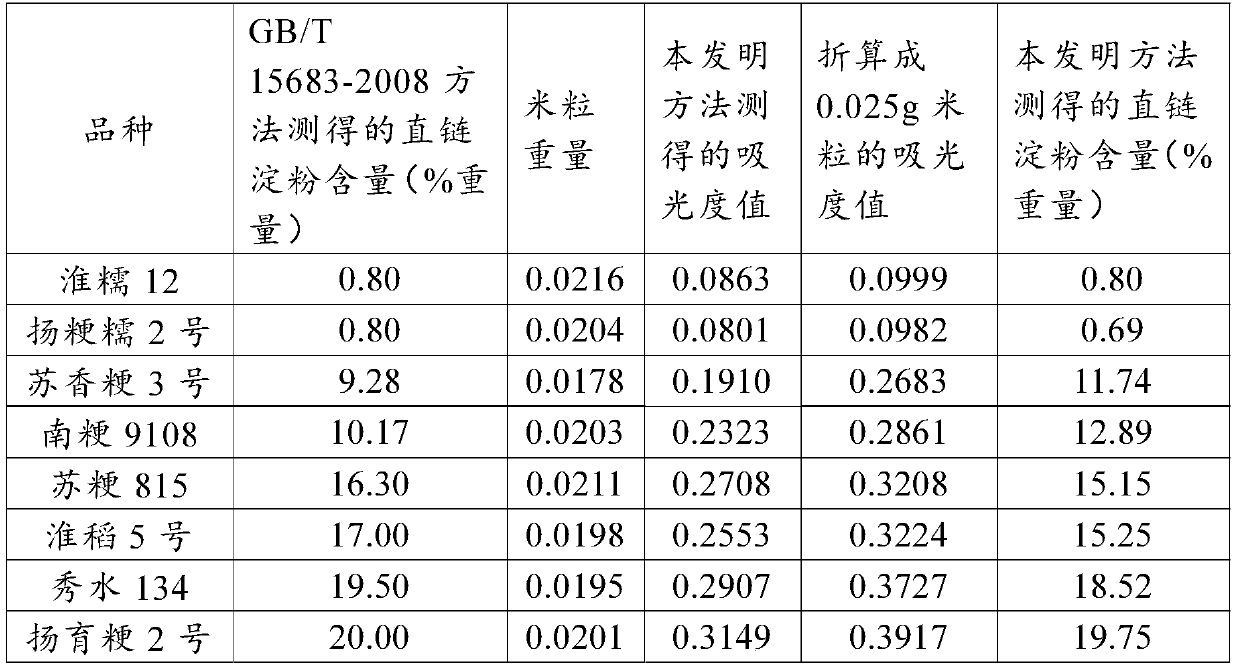Method for measuring rice amylose content through single grains of rice
An amylose content, rice technology, applied in the measurement of color/spectral properties, material analysis by observing the effect on chemical indicators, and analysis by chemical reaction of materials, etc., can solve the problem of insufficient sample volume and consumption of distilled water. It is suitable for large-scale popularization and application, and the measurement is accurate and reliable.
- Summary
- Abstract
- Description
- Claims
- Application Information
AI Technical Summary
Problems solved by technology
Method used
Image
Examples
Embodiment 1
[0051] Four rice varieties were selected as reference samples, namely Zhennuo 19 (obtained from the Zhenjiang Agricultural Science Research Institute in the hilly area of Jiangsu), Songzaoxiang 1 (obtained from the Agricultural Technology Extension Center of from Wujin Rice Research Institute), Nanjing No. 11 (acquired from Jiangsu Academy of Agricultural Sciences).
[0052] Eight rice varieties were selected as the samples to be tested, namely Huainuo 12 (obtained from the Huaiyin Agricultural Science Research Institute in Xuhuai District, Jiangsu Province), Yangjingnuo 2 (obtained from the Lixiahe District Agricultural Science Research Institute in Jiangsu Province), Suxiangjing No. 3 (obtained from Suzhou Academy of Agricultural Sciences), Nanjing 9108 (obtained from Jiangsu Academy of Agricultural Sciences), Sujing 815 (obtained from Jiangsu Zhongjiang Seed Industry Co., Ltd.), Huaidao No. 5 (obtained from Jiangsu Xuhuai District Huaiyin Agricultural Science Research Ins...
Embodiment 2
[0065] Four rice varieties were selected as reference samples, namely Zhennuo 19 (obtained from the Zhenjiang Agricultural Science Research Institute in the hilly area of Jiangsu), Songzaoxiang 1 (obtained from the Agricultural Technology Extension Center of from Wujin Rice Research Institute), Nanjing No. 11 (acquired from Jiangsu Academy of Agricultural Sciences).
[0066] Six rice varieties were selected as the samples to be tested, namely Huajing 5 (obtained from Jiangsu Dahua Seed Industry Group Co., Ltd.), Yangjing 5118 (obtained from Jiangsu Lixiahe Regional Agricultural Science Research Institute), Suxiangjing 100 No. (obtained from Suzhou Academy of Agricultural Sciences), Nanjing 5055 (obtained from Jiangsu Academy of Agricultural Sciences), Xudao No. 9 (obtained from Xuzhou Institute of Agricultural Sciences), Yanjing 16 (obtained from Agricultural Sciences of Yandu District, Yancheng City graduate School).
[0067] The rice of the reference sample and the sample...
Embodiment 3
[0079] Four rice varieties were selected as reference samples, namely Zhennuo 19 (obtained from the Zhenjiang Agricultural Science Research Institute in the hilly area of Jiangsu), Songzaoxiang 1 (obtained from the Agricultural Technology Extension Center of from Wujin Rice Research Institute), Nanjing No. 11 (acquired from Jiangsu Academy of Agricultural Sciences).
[0080] Eight rice varieties were selected as samples to be tested, namely Fujing 1606 (obtained from Jiangsu Shennong Dafeng Seed Industry Technology Co., Ltd.), Huzaoxiangruan No. 2 (obtained from Shanghai Academy of Agricultural Sciences), Lianjing 15 (obtained from Lianyungang Municipal Academy of Agricultural Sciences), Shengdao 18 (obtained from Shandong Rice Research Institute), Sidao 15 (obtained from Suqian Agricultural Science Institute, Jiangsu Academy of Agricultural Sciences), Wuyunjing 32 (obtained from Jiangsu Wujin Rice Research Institute), Xindao 22 (obtained from Xinxiang Academy of Agricultura...
PUM
| Property | Measurement | Unit |
|---|---|---|
| Concentration | aaaaa | aaaaa |
| Diameter | aaaaa | aaaaa |
Abstract
Description
Claims
Application Information
 Login to View More
Login to View More - R&D
- Intellectual Property
- Life Sciences
- Materials
- Tech Scout
- Unparalleled Data Quality
- Higher Quality Content
- 60% Fewer Hallucinations
Browse by: Latest US Patents, China's latest patents, Technical Efficacy Thesaurus, Application Domain, Technology Topic, Popular Technical Reports.
© 2025 PatSnap. All rights reserved.Legal|Privacy policy|Modern Slavery Act Transparency Statement|Sitemap|About US| Contact US: help@patsnap.com



